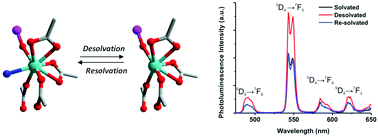The structure, stability, gas sorption properties and luminescence behaviour of a new lanthanide-phosphine oxide coordination material are reported. The polymer PCM-15 is based on Tb(III) and tris(p-carboxylated) triphenylphosphine oxide and has a 5,5-connected net topology. It exhibits an infinite three-dimensional structure that incorporates an open, two-dimensional pore structure. The material is thermally robust and remains crystalline under high vacuum at 150 °C. When desolvated, the solid has a CO2 BET surface area of 1187 m2 g−1 and shows the highest reported uptake of both O2 and H2 at 77 K and 1 bar for a lanthanide-based coordination polymer. Isolated Tb(III) centres in the as-synthesized polymer exhibit moderate photoluminescence. However, upon removal of coordinated OH2 ligands, the luminescence intensity was found to approximately double; this process was reversible. Thus, the Tb(III) centre was used as a probe to detect directly the desolvation and resolvation of the polymer.

You have access to this article
 Please wait while we load your content...
Something went wrong. Try again?
Please wait while we load your content...
Something went wrong. Try again?


 Please wait while we load your content...
Please wait while we load your content...